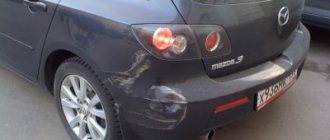Troubles on the roads can happen to every driver. Sometimes this is not affected by experience or driving skill. Sometimes a new driver can cause an accident on the road, and sometimes weather conditions cause an accident. Regardless of what caused the accident, everyone involved suffers financial and emotional damage. The worst thing is when difficulties arise in obtaining insurance payments. It is required to consider the main insurance cases under CASCO.
What applies to them
Under a CASCO agreement, the occurrence of an event obliging the insurance company to cover damage caused to vehicles may be recognized as an insured event.
The terms of coverage must be discussed in the insurance contract, which must be drawn up in compliance with certain rules and regulations of current legislation.
An insured event is determined by the risk that is included in the insurance coverage of the CASCO policy under the insurance contract.
They are divided into two groups:
- damage is manifested in the risk of damage, complete destruction of the car as a result of an emergency situation on the roads, leading to an accident. These include collisions of vehicles, their collision with each other, their overturning, falling into a ditch, ravines, collision with another vehicle when it is parked;
- theft occurs in the case of theft, robbery, illegal taking, without intent to steal.
The insurance company individually determines the risks from which types of risks it is ready to protect its clients. However, as practice shows, the set of risks is standard. It depends on the package purchased by the client, which can be either extended or reduced.
When concluding a CASCO agreement, the policyholder is given the following:
- a policy confirming the rights of the car owner;
- CASCO insurance rules, the content of which explains the procedure for action in the event of an event that can be recognized as insurance;
- a memo to the policyholder containing information about the insurance company and contact details.
Payments under CASCO
Payments will directly depend on what kind of policy you have and what happened. As a rule, companies send payment within 30 days from the date of approval of your application. If no additional checks are required, and they immediately believe you (the situation is obvious), then you can get the money in two weeks.
The application itself is considered for as long as specified in the contract. Be sure to check if there is a similar clause in it, since this is where insurance companies put off everything and put off consideration until it is too late to pay someone something.
Payments are transferred to the client's account - you should have indicated it when registering the policy. In this case, the money can be:
- free - without being tied to what they must do;
- for intended use - if the insurance company pays for repairs, for example.
Also, during repairs, payments often go directly to the repairman who will restore the car.
Insured event without an accident
The owner of a vehicle has the right to insure it against other types of risks as a result of which insured events arise related to its damage as a result of:
- fire, unauthorized combustion, uncontrollable combustion;
- explosion, regardless of the reasons;
- natural disaster caused by natural disasters. For example, earthquake, hurricane wind. To receive the due payment, you must submit to the insurance company identification documents issued by the meteorological service;
- hit by stones of various diameters, their falling, falling snow, tearing off ice;
- illegal actions committed in relation to vehicles by third parties;
- damage to the body due to involuntary exposure to animals.
Will they pay CASCO if they themselves damaged the car?
The use of CASCO is voluntary; insurance companies offer various options for its registration. Therefore, in order to protect yourself from unwanted accidents, wisely choose the most suitable service package.
The owner of a CASCO policy receives compensation only in cases where this is provided for in the concluded agreement.
If comprehensive insurance was provided, it will include the following insured events:
- All types of damage that result from being involved in a traffic accident.
- When problems with the car are the result of natural disasters (for example, due to a hurricane, a tree fell in the parking lot and damaged the car).
- If the car fell into the ground or fell under ice.
- In the case where the damage is caused by intruders.
- When the theft from the parking lot occurred.
- If any part of the car is stolen.
Self-inflicted harm may include the following:
- The car was damaged due to improper entry into the garage.
- The bumper was damaged while parking.
- Drunk driving.
- Scratched on the curb.
- Getting into a ditch.
When considering situations where the driver himself caused damage to his car, it is necessary to prove that it was not his fault.
What doesn't apply to them
Along with those classified as insurance, in practice there are often cases that the insurance company does not regard as insurance. The policyholder must have strong arguments to prove that he is right in recognizing the case by the insurance company.
Such situations are created when:
- the car at the time corresponding to the incident was driven by another person who was not included in the list of persons allowed to drive;
- the driver does not have a driver’s license, its validity period has expired, it does not indicate the required category, there is no power of attorney from the owner of the vehicle allowing him to drive the vehicle;
- the driver was drunk or under the influence of narcotic or toxic substances;
- the incident was committed under the influence of medications that are officially contraindicated when driving vehicles.
In addition to the cases listed above, these include cases committed by the driver due to negligence in driving.
These include:
- the vehicle was not put on the handbrake, as a result of which it moved, leading to damage;
- careless use of fire led to a fire inside the car;
- the movement of vehicles was carried out on territory not included in the highway;
- the fuel or brake system, steering, or engine have been changed without obtaining the appropriate permission from the traffic police;
- intentionally causing damage in order to receive payments under the CASCO agreement.
Each insurance company has the right to set individual criteria for assessing an incident for its clients in order to classify the case as insurable and make a payment in accordance with the CASCO policy.
However, the policyholder needs to more carefully study the terms of the contract and the Rules under which payment is made in order to avoid future unpleasant situations.
The CASCO Confident Driver program from the VSK company is discussed in the article: CASCO VSK. Read about the conditions of the CASCO Comfort program of the Ingosstrakh company at this link.
What does CASCO insure?
The main ones include standard conditions that insurers offer to all car owners. Under this type of risk, the car owner is able to receive compensation for damage if his property suffers from the following troubles:
- fire;
- spontaneous combustion;
- Road accident involving two or more cars;
- hitting fixed objects (including poles, curbs, fences, and other cars);
- falling of foreign objects, ice and layers of snow onto the car;
- intentional actions of third parties, including vandalism;
- hijacking;
- theft of car parts, mirrors, wheels;
- consequences of natural disasters, including damage from lightning, falling trees, floods, hail, earthquakes or landslides.
Each insurer has the right to independently establish a list of additional risks that give the owner the right to receive insurance payments. This means that auto insurance programs will vary from company to company.
Adding or excluding certain insurance cases from the list will affect not only the completeness and quality of the service received, but also the final cost of the policy.
When deciding on voluntary car insurance, you should not rely on the terms of the contract concluded by a neighbor, relative or acquaintance. For some, the companies with which they cooperate may, for example, pay for the restoration of paintwork damaged by scratches or abrasions, while for others, they will refuse to compensate for damage from theft if the car was stolen from an unguarded parking lot.
Before buying a policy, the car owner needs to carefully study the proposed conditions and discuss with a representative of the insurer what CASCO gives him, and what compensation for losses he can firmly count on. If for some reason the car owner has not discussed with the insurance company manager the terms of the contract under which his car is insured, he can find a complete list of risks on the back of the policy.
To reduce the cost of the policy, some car owners ask the insurer to exclude car theft from the main risks. Today, many cars are equipped with modern anti-theft systems, and vigilant owners try to store their vehicles in a garage or in a guarded parking lot. Under such conditions, it is really difficult to steal a car. And insurers met the wishes of clients. The “Theft” column on the policy form can either be crossed out, or a tariff that reduces the cost of insurance can be added to it.
However, before deleting the risk of theft from the policy, the owner should once again assess the degree of security of the car. After all, he can no longer hope for compensation for this damage if the car thieves turn out to be more cunning than the security measures taken.
What to do if an adverse event occurs
If there has been an insured event, then it is necessary to focus on the rules and follow its requirements in order to receive the due payment without unnecessary “bureaucracy”.
In accordance with the above document it is necessary:
- immediately notify the insurance company about the insured event, provide contact details, insurance contract number, car details;
- timely submit an application to the insurance company, filled out on a special form, and attach the necessary documents to it;
- provide the damaged vehicle for inspection on the day of submission of the application, and take part in it. If it is impossible to transport the vehicle to the designated place, it is carried out in the place where the person authorized by the insurance company is located;
- As soon as possible, you must submit an application to the company where the CASCO policy was purchased. In it, describe in detail the event that occurred, ask for payment to be made in accordance with the terms of the contract, provide links to the norms of legislative acts, provisions enshrined in the Insurance Rules.
The wait for a decision made by the insurance company, according to current legislation, is 20 calendar days.
At the end of the established period, she is obliged to give a positive answer or refuse to satisfy the demands of the insured, which must be reasoned.
If there is no response from the insurance company, you will need to call the Direct Claims Adjustment Department or the hotline to find out.
Car theft
CASCO covers natural disasters along with the risks of theft, damage and loss of a car. However, when concluding a contract, you need to clarify the specific list of natural phenomena, the consequences of which are compensated by the purchased insurance.
What natural disasters does voluntary insurance protect against? The usual list of insurance cases contains types of damage that can be caused to a vehicle as a result of:
- earthquakes;
- floods;
- shards of ice and icicles falling from roofs;
- mudflows and landslides;
- hail and snow;
- fallen tree trunks;
- heavy winds, hurricanes, tornadoes and tornadoes;
- natural fires;
- landslides and rockfalls;
- volcanic eruptions;
- avalanche.
But in practice, not everything goes as smoothly as on paper. In some cases, insurance companies, trying to minimize their own costs, try to avoid payments. To avoid liability, they refer to the presence of circumstances that prevent them from recognizing what happened to the car as an insured event.
If the car was damaged by natural disasters included in the service package, the car owner must follow the procedure provided for in such a case. The main task for the motorist is the need to provide evidence that damage to his property was caused precisely as a result of a natural phenomenon that occurred. The following actions should be taken by the car owner in the event of an insured event:
- Contact the police and the Ministry of Emergency Situations to report the incident:
- if the situation allows, the owner must wait for the employees of these authorities without leaving the scene of the incident;
- if it is impossible to remain in place without risking damage to health or life, you should independently visit the police department or the Ministry of Emergency Situations and obtain from the employees of these bodies a certificate that describes in detail how and what the car was damaged, including a list of damages received by the car.
- Prove the occurrence of a natural disaster:
- submit a written request to the service that monitors the state of the environment, for example, the Hydrometeorological Center;
- obtain a document recording the place, time and type of natural disaster, as well as its characteristic features and quantitative characteristics.
- Notify your insurance company about the incident and check with the manager about the next steps.
- If possible, take photographs of the scene of the incident if the situation makes it possible to do so.
Particular attention should be paid to situations where the car was damaged by the actions or inaction of utility or road repair services. If it fell into an open hatch, or icicles that were not knocked down by utility workers fell onto it from the roof, when drawing up a report at the police department, do not let the employees make a note that you, as the injured party, have no claims against representatives of the Management company, housing and communal services workers or repair team.
Voluntary insurance is certainly a reliable protection for the car owner’s property. Despite its high cost, if the car gets into a difficult traffic situation, in the event of its theft or damage from a natural phenomenon or the hands of third parties, the CASCO policy will more than recoup the money spent on it. Especially if we are talking about a new car of an expensive model, or a car purchased on credit. But in order to avoid misunderstandings, it is necessary, during the process of concluding a contract, to carefully study all the conditions of the program offered by the insurer and clarify all the risks that, if necessary, the purchased policy will cover.
It is necessary to remember the algorithm of actions in the event of any insured event:
- in case of an accident - immediately call authorized traffic police officers;
- for CASCO without an accident - request information from the meteorological service, any written confirmation from authorized persons.
The first step is to notify the insurance company about the insured event. Two ways: electronic application on the official website and write a statement about the occurrence of an insured event at the territorial office of the insurer at your place of residence (car registration). Duration – within 5 days. In case of an accident, notify the inspectors immediately after the accident.
Second step: prepare a list of documents specified in the CASCO agreement. The list is exhaustive and the insurance company does not have the right to expand it not in the interests of the policyholder. The CASCO insurance company is obliged to make a decision on compensation for the insured event within 20 days from the date of receipt of the application (application) of the policyholder. In exceptional cases, the insurer may request clarifying data on the insured event to determine the amount of damage and compensation.
List of documents
If you have a CASCO insurance policy (original only), you must attach to it a copy of your passport, a diagnostic card (copy and original), documents confirming the insured event (an explanation to the police, a vehicle inspection report), and a copy of the application to the insurance company for notification of damage under CASCO.
Sample application
A standard claim for compensation due to an insured event is as follows:
- full name of the territorial office;
- I inform you that I, the owner of the CASCO policy (number and date of registration of the agreement), was involved in an accident (indicate the date and place of the incident). Immediately, the police were called on my part to investigate the guilt and circumstances of the incident. On the same day, I submitted a notification about the insured event (copy in the attachment). Please calculate the amount of damage and identify a technical repair station to eliminate all faults and damage. I ask you to ensure the implementation of this application for CASCO damage within 20 days;
- current date and signature.
If an insured event occurs, you must:
- Make sure that it is included in the list of cases described in the insurance contract.
- Record what happened - this is done with the help of the traffic police or the police (depending on the nature of the case). Also, it is better to inform the insurance company immediately or within the period specified in the insurance contract.
- Collect documents and write an application to the Investigative Committee.
- Wait for a technical inspection of the car (submit the car for technical inspection) and a specialist’s opinion on the nature of the damage, its causes and further actions.
- Based on the results of the verification, receive a payment.
Despite the prevalence of comprehensive insurance, many car owners/drivers make a lot of mistakes during insurance cases. The main ones relate to ignorance of the list of documents and errors in their execution.
Insurance Act
A CASCO insurance event report is prepared by the insurance company and contains information about the incident (causes, consequences), the nature of the damage, and calculation of compensation. If the policyholder is not satisfied with the payments, then usually a copy of the act is requested, sometimes through the court, for review and appeal.
We will tell you about other documents required to file an insurance case under CASCO below.
The list of various certificates and protocols required to register an insured event must be known in advance from the rules or other documents of the insurer. It is highly advisable to call the insurance company immediately after the incident and check the list again.
The main mistakes car owners/drivers make are in this part. Let's look at the most common ones.
- Various incidents that are not traffic accidents still require a protocol. You just need to call representatives of the nearest police department, and not the traffic police, to formalize it.
- The police officer may write in the report something like “minor damage was caused” or “the cause of the damage has not been established.” Such formulations practically inevitably lead to refusals of payments. The entire protocol should be clear, specific and as complete as possible, although sometimes this can be difficult to achieve.
- No need to neglect photo and video shooting. It is also necessary to record the insured event in this way in as much detail as possible. It is very desirable that you can find out from the photo where exactly the incident happened. To do this, it is enough to capture recognizable details in the frame - monuments, special flower beds or signs indicating a street/house.
- No certificate or protocol should contain errors, typos, or clerical errors. For example, an incorrectly specified engine number or car model. The dates and time of the event are also important. If flaws are still found, you need to demand they be corrected.
Read on to learn what to do when you have collected all the documents for a comprehensive insurance claim.
Procedure
Have all the certificates/protocols been collected? It's time to submit them to the insurance company. Here, too, it is important not to make a mistake.
- Every document that goes to the insurer must be copied.
- In the application for insurance compensation, you must indicate both the number of attached documents (with names) and the number of pages that these documents occupy.
- The insurance company employee who accepts the documents must sign for receipt. And not with some kind of squiggle, but with the indication of the surname and initials, as well as the date of adoption.
This important point is simply not defined by many insurance companies. The rules and other documents may indicate the payment period, but it is counted not from the moment of filing documents about the insured event, but from the day a positive decision is made. But how long it will be taken is unknown.
That is why it is advisable to find out the period for reviewing documents when applying for a policy. And not just hear an answer from the consultant, but see the clause of the rules that stipulates such a period.
Registration of a comprehensive insurance claim must be taken with great seriousness. This approach allows you to prevent many mistakes and negative consequences.
If the car is damaged as a result of illegal actions of third parties, you should write a statement to the territorial police department. This can be done by the owner of the car or a person who has a notarized power of attorney. The application should indicate:
- "Ask:
- Take measures to find the persons responsible for the damage (destruction) of my property (make and model of the vehicle, registration number).
- Bring the perpetrators to justice for damage (destruction) of my property.
Material damage to my property caused as a result of illegal actions of third parties is significant for me.”
What documents are needed?
The occurrence of an insured event always occurs unexpectedly, but if it occurs, then it is necessary to take timely measures to obtain compensation.
The policyholder must submit certain documents to the insurance company, which include:
- original CASCO policy;
- a receipt or payment order certifying payment for the policy;
- if available, a copy of the act, the content of which is the inspection of the car before execution of the contract;
- passport identifying the person submitting documents for consideration;
- if the interests of the policyholder are represented by another person, then a general power of attorney to negotiate payment;
- the original certificate confirming the registration of the car with the traffic police;
- diagnostic card issued by the traffic police authority at the owner’s place of residence;
- certificates stating that the insured event occurred, depending on its type.
What is CASCO
Every motorist who decides to voluntarily insure his car wants to receive guarantees and confidence that in the event of damage or loss of his vehicle, he will receive compensation for damage. However, in order to avoid serious disappointments, you should understand what CASCO covers and what troubles it can protect against.
If the conditions for payment of compensation under compulsory motor liability insurance are the same in all cases, then under voluntary CASCO policies each insurance company has the right to enter into the contract its own list of risks that are subject to compensation and to provide for various important nuances.
Insurance claim
Legislative acts have approved a special application form of a unified form. Usually the form is printed with the reverse side. It is filled out manually, in blue ink, legibly.
You cannot write with errors in it, because entries in the form cannot be corrected. It must be filled out correctly, without making mistakes, and following the rules.
Requirements for writing an application:
- the first column is used to describe the insured event, it contains the incoming number, the date of acceptance by the insurance company, the exact time of admission, the registration number of the policy, a note about the payment, the duration of the contract is entered, information about the presence of a franchise and the corresponding payment coefficients is recorded;
- the second column provides information about the official data of the insured, such as the year of manufacture, the assigned state number of the vehicle, its make, model, and the contact information of the company employee preparing the documents;
- the third contains information about establishing the type of insured event, describes a specific insured event that occurred with the policyholder, for example, suffered due to unlawful actions of third parties, hit an obstacle at the side of the road, for example, a parapet;
- in the fourth, the full date of the insured event that occurred is recorded, including the hour and minutes, the time the damage was discovered, and its characteristics;
- the fifth column describes the place where the incident occurred, it is necessary to note who was driving at the time of the incident, enter his personal data, indicate the presence of a driver’s license, note the expiration date;
- in the sixth, write down the information - if the driver was driving the vehicle by proxy, then it is necessary to indicate its validity period, data from the contents of the driver’s license;
If the vehicle was not being driven and no one was driving, then this fact must be noted in the application and a note should be made: “no one was driving, the car was discovered by P.P. Fedorov.”
- the seventh contains information about witnesses, their personal data, insurance policies, if there was an accident;
- the eighth must contain information about the authorities to which the insured event was reported, for example, about the Department of Internal Affairs, the State Traffic Safety Inspectorate, the Fire Service;
- in the ninth, enter a list of damages that the vehicle received.
If minor errors were made in the application during its execution, they must be corrected. Next to the correction, make a note: “believe the corrected one” and secure it with a signature.
Statement about an insured event.
In addition, a CASCO policy has benefits that guarantee coverage of some of the damage resulting from the impact of unpleasant, unforeseen events.
The insurance company will make payments in accordance with the provisions of the concluded contract, and, at the request of the policyholder, will issue an appointment to a technical center where it will repair the car.
Each policyholder, depending on his capabilities and wishes, selects an individual set of risks for himself in order to insure his vehicle.
However, we should not forget that a large number of risks increases the cost of a CASCO policy, so you need to be more careful about your actions.
You can find out what the rules of CASCO insurance apply to the Renaissance company in the article: CASCO Renaissance. Information on CASCO payments in case of an accident can be found here.
What is a CASCO deductible is described in this article.
Types of insurance
The CASCO agreement is an individual agreement, that is, the conditions are negotiated by the insurer with each client separately.
However, several types of such insurance contracts can be distinguished according to the method of payment:
- full coverage;
- partial coverage;
- aggregate coating;
- non-aggregate coating.
Each of the listed insurance programs has both pros and cons, which means that when choosing a suitable program, the car enthusiast will rely only on his financial capabilities and the degree of risks that he is willing to bear. So, let's look at each type separately.
Full CASCO. This type of insurance compensates for expenses incurred due to any actions leading to the occurrence of an insured event.
Full CASCO obliges you to make payments if the car is damaged in such situations:
- in any vehicle collision;
- in case of unlawful actions of other persons;
- when destroyed (damaged) by fire;
- under the influence of force majeure (weather, volcanic eruption);
- during military operations and counter-terrorism operations.
Full CASCO also provides compensation in the event that the car is stolen or completely destroyed under any circumstances. Such a program is undoubtedly very profitable, because its conditions will protect the wallet of the vehicle owner in almost any situation.
But even this type of insurance contract does not guarantee that compensation will be paid in all cases. But this already applies to the actions of the driver. For example, if at the time of the insured event the driver was in a state of alcoholic or other type of intoxication, then the insurer will almost always be able to legally refuse to pay.
Therefore, when signing a contract, it is necessary to read it carefully and, if an insured event occurs, act as the company requires.
Partial CASCO. This car insurance program involves covering only part of the risks. That is, the client of the insurance company chooses from which risks he wants to protect his vehicle. Accordingly, this entails a reduction in the price of the policy. Often, insurers offer ready-made (standard) contracts with a certain set of risks and present them as a separate product with its own name.
Such proposals include:
- CASCO Optima insurance;
- CASCO insurance against crisis;
- "Light CASCO" insurance;
- “Economical” insurance, etc.
Often, car owners decide to partially insure their car either against theft or against damage and complete destruction.
Aggregate CASCO. Also, both full and partial programs provided by insurance companies in the field of CASCO car insurance differ in the types of insurance payments. Thus, aggregate CASCO provides for payment of compensation by the insurer for damage caused, in each subsequent case less than the total amount of the contract.
To make it clearer, let's give an example. The vehicle is insured under the contract for 800,000 rubles, that is, the owner will receive a payment in exactly this amount if his car is stolen or it cannot be restored due to the occurrence of an insured event. Let’s say that some time after the conclusion of the contract, damage is discovered, for which the insurer paid 50,000 rubles.
If during the validity period of the same contract the vehicle is damaged in a major accident, then the maximum amount of compensation will not be 800,000 rubles, as indicated in the policy, but only 750,000 rubles, since 50,000 rubles have already been “spent” by the insured. Accordingly, when subsequent cases involving the payment of compensation occur, the maximum amount will decrease.
Thus, aggregate payments are most suitable for an incomplete CASCO insurance program. Most often, the insurer gives the client the right to choose the type of payments, but it also happens differently. Therefore, before signing an agreement and giving the agent money, you need to discuss all aspects of the agreement with him, and also read each of its clauses yourself. If you have any doubts, you should contact another insurer.
Non-aggregate CASCO. This is exactly the type of insurance program that credit institutions often require when approving an application for a car loan. After all, no matter what happens, no matter what damage is caused to the car, the insurer is obliged to pay the full amount of damage caused (within the contract limit).
For example, the insurance amount is 500,000 rubles. The driver receives payments for damage several times in the amount of 100,000, 50,000 and 250,000 rubles, that is, during the validity of the contract, the insurer paid him 400,000 rubles. After this, the insured car is stolen. In this case, the compensation will be 500,000 rubles, that is, it will not depend on previous payments.
Legislative regulation of CASCO
Currently, there is no special federal law regulating the list of insurance cases under CASCO. The activities of participants in the voluntary vehicle insurance market are regulated by the Law of the Russian Federation No. 4015-1 of November 27, 1992 “On the organization of insurance business in the Russian Federation.” According to this document, insurers and their associations have the right:
- independently establish rules for voluntary property insurance;
- determine the list of insured events and risks;
- establish the procedure for determining the amount of damage, the insured amount, premium and tariff;
- approve the procedure for concluding and terminating an insurance contract;
- determine the procedure for payment of compensation;
- draw up a list of grounds for refusing compensation for damage.
The rules of insurance companies regarding what CASCO covers and in what order damages are compensated must be drawn up in such a way that they do not contradict the Civil Code of the Russian Federation, other federal and local laws. The conditions for drawing up an insurance contract are regulated by Articles 929 and 943 of the Civil Code of the Russian Federation. The rules of a particular company must be public in nature and be in the public domain for those who wish to familiarize themselves with them.










